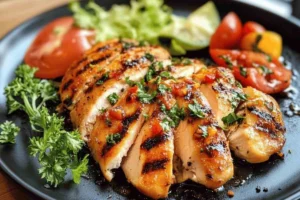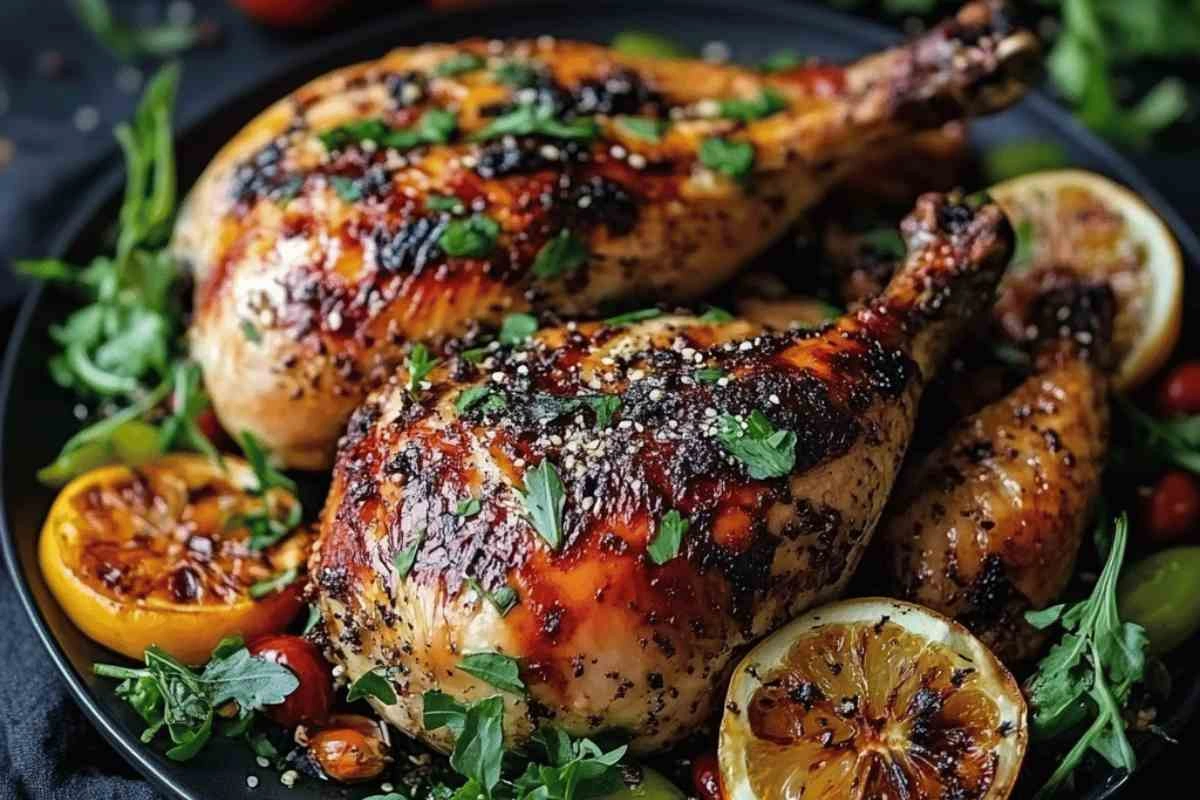Finding the secret to crispy turkey skin is all about the right techniques and preparation. Getting that golden-brown, crispy skin makes your dish look and taste amazing. Whether it’s for a big holiday meal or a small get-together, knowing how to get crispy turkey skin is key. We’ll share the essential steps to make your turkey skin perfect, so you can enjoy its crispy texture.

Understanding the Importance of Crispy Skin
Turkey skin is more than just a look. It adds a special touch to your meal, blending crunch with juiciness. This makes your turkey not just tasty but also visually appealing.
When done right, the skin’s crunch complements the soft meat inside. This mix of textures makes every bite a delight. To get that perfect crunch, keeping the meat moist and cooking at the right temperature is key.
Using methods like dry brining and high heat can make your turkey skin crispy. A turkey with golden, crispy skin is not only delicious but also a showstopper at any event.
Don’t overlook the role of turkey skin in your cooking. A turkey with crispy skin is the start of a memorable meal. It highlights the texture and flavor everyone loves.
What is the trick to crispy skin on turkey?
Getting crispy turkey skin can make your holiday meal unforgettable. The mix of flavors and textures is key. Secrets to crispy skin involve several factors that come together to make each bite special.
Why Crispy Skin Matters
Crispy skin is important for many reasons. It adds a satisfying crunch that contrasts with the soft meat. This texture makes every bite more enjoyable. Many people say crispy skin is a sign of a perfectly cooked turkey.
The Role of Texture in Roasted Turkey
Texture is crucial for enjoying roasted turkey. Crispy skin shows off a golden exterior that complements the meat’s flavors. Using baking powder and kosher salt helps improve the skin’s texture.
Letting the mixture rest on the skin for 12 to 24 hours in the fridge is key. This step increases pH levels, breaking down proteins better. Cooking at 425 degrees Fahrenheit ensures the skin is shatteringly crisp, a favorite among turkey fans.
Essential Techniques for Achieving Crispy Skin
To get crispy turkey skin, you need to prepare well and use key methods. Dry the skin well and use techniques that make it crispy and flavorful. Follow these steps to learn how to get crispy turkey skin.
Pat Dry Method
Drying the turkey skin is a simple yet effective method. Use paper towels to dry the outside and inside of the bird. Refrigerate the turkey uncovered for at least 12 hours. This method helps the skin get crispy by removing moisture before roasting.
Baking Powder Application
Using baking powder can make your turkey skin better in texture and taste. Mix baking powder with salt and apply it to the skin. Sprinkle it all over to ensure even coverage. As the turkey cooks, the baking powder helps the skin become crispy and adds flavor.
| Technique | Description | Benefits |
|---|---|---|
| Pat Dry Method | Drying the turkey skin thoroughly using paper towels and refrigerating uncovered. | Reduces moisture, leading to crispier skin. |
| Baking Powder Application | Sprinkling a mixture of baking powder and salt onto the turkey skin. | Enhances crispiness and flavor through a chemical reaction. |
By using these techniques, you can make a roast with crispy skin. It looks great and tastes amazing, with a crunchy texture in every bite.
Drying the Turkey: The Key Step
Drying the turkey well is key for that crispy skin. Using good turkey drying methods can really improve your roasting. A top way to dry turkey in the fridge is to remove extra moisture first. This lets the skin get crispy.
Refrigeration Techniques
Leaving the turkey uncovered in the fridge is a great method. It lets air move around the bird, helping moisture to dry. Refrigerate the turkey for 24 hours before roasting for the best results.
This not only dries the skin but also makes the turkey taste better. If you’ve used salt and seasonings, they will work better.
Timing for Maximum Results
Timing is important when getting your turkey ready. Start drying the turkey one to two days before cooking. This gives enough time for the skin to dry perfectly.
Exposing the turkey for the last six hours in the fridge can make the skin even crisper. This is because the surface moisture keeps evaporating.
How to Use Oil for Crispiness
Oil is key for a crispy turkey skin. Putting oil on before roasting makes the turkey’s skin better in texture and taste. The right oil can make the skin crispy and brown, which tastes amazing. Here are some oils to try and how much to use for the best results.
Types of Oil to Use
- Olive oil: A favorite for its high smoke point and rich flavor.
- Vegetable oil: Great for a golden brown look.
- Duck fat: Chefs love it for its flavor and crispiness.
Amount of Oil for Best Coverage
For even coverage, mix 2 tablespoons of olive oil with 2 tablespoons of melted butter. This combo adds moisture and crispiness. Coat the turkey evenly to get a nice brown color. A well-oiled turkey is crucial for a crispy skin.
| Type of Oil | Flavor Profile | Smoke Point (°F) | Additional Benefits |
|---|---|---|---|
| Olive Oil | Rich and fruity | 375 | Enhances flavor |
| Vegetable Oil | Neutral | 400 | Cost-effective |
| Duck Fat | Rich and savory | 375 | Exceptional crispiness |
Importance of Seasoning Properly
Seasoning your turkey right is key to better flavor and texture, especially for crispy skin. The right herbs and spices can make a big difference. They add great taste and change the whole dining experience.
Choosing the right seasonings and how you apply them matters a lot. A well-seasoned turkey stays moist and gets that crispy skin you want.
Selecting the Right Herbs and Spices
Picking the right herbs and spices is crucial for a tasty turkey. Some favorites include:
- Rosemary
- Thyme
- Parsley
- Black pepper
- Garlic powder
These herbs add flavor and help keep the turkey moist. They also help make the skin crispy when cooked right.
The Effect of Salt on Turkey Skin
Salt is important for seasoning, adding flavor and controlling moisture. When you use salt, it pulls moisture out of the skin. This makes the turkey less soggy and helps the skin get crispy.
Here’s how to season your turkey well:
| Method | Description | Recommended Timing |
|---|---|---|
| Dry Brining | Salt is rubbed on the turkey’s surface and left to rest, allowing flavors to penetrate. | 16-24 hours before cooking |
| Butter Application | Softened butter can be used under the skin directly to enhance flavor while promoting crispiness. | Before roasting |
Using these methods will help your turkey skin get crispy. The right seasoning and texture make your turkey a hit at any gathering.
Achieving Perfect Roasting Conditions
Creating the right environment for roasting makes your turkey taste better and feel softer. The key is to find the perfect oven temperature. This ensures the skin gets crispy and the meat stays juicy. Here are some tips to help you roast your turkey perfectly.
Choosing the Right Oven Temperature
The best oven temperature for turkey is about 425°F. This high heat helps cook the turkey evenly and makes the skin crispy. Start at 350°F to cook the turkey through, then raise the temperature to 425°F for a golden-brown finish.
Don’t baste the turkey. Instead, use duck fat or olive oil for extra flavor. This makes the roasting process easier.
Positioning the Turkey in the Oven
Where you put the turkey in the oven is very important. Place it in the center for the best air circulation. Don’t tie the legs too tight, as this can cause uneven cooking.
You can put herbs or garlic in the cavity for extra flavor. This will make your turkey smell and taste amazing.
| Oven Temperature | Effect on Cooking |
|---|---|
| 350°F | Initial cooking for even heat distribution |
| 425°F | Crispy skin and golden finish |
Air-Drying Techniques for Excellent Skin
Air-drying your turkey can make the skin crisp and delicious. When you let it sit uncovered in the fridge, moisture escapes. This makes the outside dry, which crisps up nicely when roasted.
Benefits of Air-Drying Uncovered
One big plus of air-drying turkey is the better skin texture. This leads to a tastier final dish. The dry outside crisps up while cooking, offering a nice contrast to the soft meat inside.
Duration and Safety Considerations
For air-drying turkey, you need at least a few hours, or even overnight. Remember to follow fridge safety rules. Make sure the turkey stays in the fridge and doesn’t stay out too long. Using the right air-drying methods improves taste and keeps food safe, preventing bad bacteria.
Basting: To Baste or Not to Baste
Basting is a common method used when roasting turkeys. It aims to add flavor and make the turkey look good. By using the turkey’s juices on its skin, basting can make the meat moist. However, it might also make the skin soggy instead of crispy.
Knowing how basting affects turkey skin is key. It helps you balance moisture and crispiness.
Pros and Cons of Basting
Basting has both good and bad sides. Some people think it makes the turkey taste better. But, there are downsides:
- Too much moisture can make the skin pale.
- Opening the oven can lower the temperature by up to 25 degrees in 30 seconds.
- Basting can make the turkey cook longer, which might dry it out.
How Basting Affects Crispy Skin
When you baste, the juices go over the skin, not into the meat. This might make the turkey less juicy. Instead, try drying the turkey before roasting for crispy skin.
Some chefs suggest salting and chilling the turkey for up to three days without basting. This helps get a golden, crispy skin.
For an even crisper skin, use clarified butter. It has no water, so it won’t make the skin soggy. If you do baste, do it less often to keep the flavor and moisture right. Covering the turkey with foil after roasting helps keep the skin crispy by stopping steam from softening it.

Using a Rack for Optimal Cooking
Cooking turkey on a rack is a big step towards a tasty meal. The turkey roasting rack is very important. It lifts the bird and lets air circulate, which helps cook it evenly.
This even cooking is key for a crispy skin. It’s what makes your turkey special.
The Role of Air Circulation
Airflow is crucial when roasting turkey. A rack lets hot air circulate around the turkey. This stops moisture from building up on the bottom.
This method cooks the turkey better and makes the skin crispy. Keeping moisture away is important for texture and flavor. It makes your meal better.
Choosing the Right Rack
Choosing the right roasting rack is important for a great dish. Look for a rack that holds the turkey’s weight well and lets air flow. Stainless steel or cast iron racks work best for different temperatures.
There are different types of racks, like V-shaped and flat ones. Each has its own use in cooking turkey. Here are some things to think about when picking a rack:
| Rack Type | Features | Best For |
|---|---|---|
| V-Shaped | Supports the turkey securely, enhances stability | Whole roasted turkey |
| Flat | Easier to fit in various pans, often more lightweight | Smaller birds, or when cooking multiple items |
| Adjustable | Can be resized to fit larger or smaller turkeys | Versatile turkey sizes |
Common Mistakes to Avoid
When cooking a turkey, many turkey cooking mistakes can ruin the crispiness of the skin. Knowing these mistakes helps make your turkey the star of the holiday. Two big areas to watch are moisture traps and seasoning errors.
Moisture Traps—Where They Occur
Moisture can sneak up on you, ruining the crispy skin you want. Here are some common places where moisture builds up:
- Putting the turkey in the oven wrong, which blocks air flow.
- Using a roasting pan that holds too much liquid.
- Sealing the turkey too tight, causing steam to build up.
By avoiding these mistakes, you can keep your turkey skin crispy and delicious.
Over-Seasoning or Under-Seasoning Issues
Seasoning mistakes can mess up both taste and skin texture. Too much or too little seasoning can cause problems:
- Over-seasoning makes the turkey taste too strong, hiding its natural flavor.
- Under-seasoning makes the meat taste bland and lacks depth.
To get your turkey’s flavor just right, season it evenly. Spread your herbs and spices on the outside and inside. This prevents clumps that hold moisture.
Conclusion
To sum up, getting crispy turkey skin is all about the details. Spatchcocking makes your turkey look great and ensures every bit of skin gets hot. This results in a crispy texture everyone loves.
Using a high heat of 450°F cuts down cooking time. You can have a perfectly cooked turkey in just 80 minutes.
Spatchcocking also cooks the turkey evenly. It keeps the meat moist by using its own fats. Plus, you can make a tasty gravy from the removed backbone.
For crispy turkey skin, mix preparation, seasoning, and cooking conditions. These steps will make your turkey look and taste amazing. Your guests will love it, and you’ll feel like a pro in the kitchen.
FAQ
How to Get Extra Crispy Turkey Skin?
To achieve extra crispy turkey skin, pat the skin dry with paper towels before cooking. Moisture is the enemy of crispiness. Allow the turkey to air-dry in the fridge, uncovered, for several hours or overnight. Season generously with salt and apply a thin layer of oil, which promotes even browning. Cook at a higher temperature (around 400°F for the first 20-30 minutes) before lowering the heat to finish roasting.
What is the Secret to Crispy Skin?
The secret to crispy turkey skin lies in preparation. Drying the skin thoroughly, salting it well, and ensuring the oven temperature is hot enough for the skin to crisp are crucial steps. Air-drying the turkey in the refrigerator and avoiding excessive basting (which can make the skin soggy) also contribute to perfectly crispy results.
Should You Put Butter or Oil on Turkey Skin?
While butter adds flavor, oil is the better choice for achieving crispy turkey skin. Butter contains water, which can inhibit crispiness, whereas oil creates a consistent, high-heat barrier that helps the skin brown evenly. If you prefer butter for flavor, rub it under the skin instead of on top.
Does Baking Soda Make Turkey Skin Crispy?
Yes, baking soda can help make turkey skin crispy. When mixed with salt and applied to the skin, the baking soda raises the skin’s pH, breaking down proteins and promoting browning. Use a small amount, as too much can affect the flavor. Rinse off excess baking soda before cooking for the best results.

